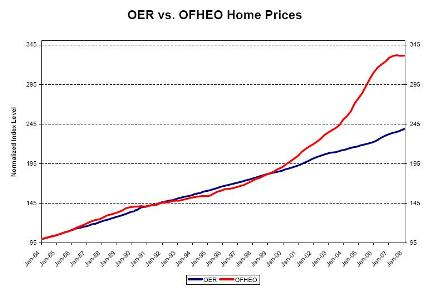
Unless home prices fall quite a bit more there will still be upward pressure on OER (owner equivalent rents), a major component of core CPI.


Unless home prices fall quite a bit more there will still be upward pressure on OER (owner equivalent rents), a major component of core CPI.
After the speech, crude up $1.61 and back over $100.
Yields down on fixed income as markets anticipate Fed won’t respond to inflation anytime soon:
February 26, 2008
The U.S. Economy and Monetary Policy
(SNIP)
Several major developments are shaping current economic performance, the outlook, and the conduct of monetary policy. The most prominent of these developments is the contraction in the housing market that began in early 2006. Both the prices and pace of construction of new homes rose to unsustainable levels in the preceding few years. For a time, the resulting correction was largely confined to the housing market, but the consequences of that correction have spread to other sectors of the economy.
The financial markets are playing a key role in the transmission of the housing downturn to the rest of the economy.
(SNIP)
The result has been a substantial tightening in credit availability for many firms and households.
At the same time, continued sizable increases in the prices of food, energy, and other commodities have raised inflation. To some extent, those increases have resulted from strong demand in rapidly growing emerging-market economies, like China and India. But the increases likely also reflect conditions such as adverse weather in some parts of the world, the use of agricultural commodities to produce energy, and geopolitical developments that threaten supplies in some petroleum-producing centers. The higher prices have eroded the purchasing power of household income, adding to restraint on spending.
(SNIP)
Recent Economic and Financial Developments
The pace of real economic activity stepped down sharply toward the end of last year and has remained sluggish in recent months. Real gross domestic product (GDP) is estimated to have risen only slightly in the fourth quarter. The contraction in the housing market continues to drag down economic growth. Declines in real residential investment subtracted nearly 1 percentage point from the overall increase in real GDP in 2007. Even so, the inventory of unsold new homes remains unusually high, because the demand for housing has fallen about as rapidly as the supply. Problems in the subprime market have virtually cut off financing in this sector. Prime jumbo mortgages are being made, but the lack of a secondary market has caused the spread between rates on these mortgages and on those that have been eligible for purchase by Fannie Mae and Freddie Mac to widen substantially. Even the standards for conforming mortgages have been tightened of late. Weak demand, in turn, is leading to widespread declines in the actual and expected prices of houses, further discouraging buyers. Starts of new single-family homes continued to fall in January, dropping to fewer than 750,000 units–a level of activity more than 1 million units below the peak in early 2006. Judging from the further decline in permits last month, additional cutbacks in construction are likely. It appears that the correction in the housing market has further to go.
For the better part of the past two years, the trouble in the housing market was contained; however, over the past several months, the weakness appears to have spread to other sectors of the economy. Tighter credit, reductions in housing and equity wealth, higher energy prices, and uncertainty about economic prospects seem to be weighing on business and household spending. Labor demand has softened in recent months. Private nonfarm payrolls were little changed in January, and the unemployment rate moved up to 4.9 percent, on average, during December and January, after remaining around 4-1/2 percent from late 2006 through most of 2007. The higher level of weekly claims for unemployment insurance suggests continued softness in employment this month.
Agreed, the economy has hit the ‘soft spot’ previously forecast by the Fed and private economists.
Apart from the labor market, the hard data on economic activity in the first quarter are limited, but, on the whole, the data suggest economic activity has remained very sluggish. Retail sales were up moderately in nominal terms in January, but after adjusting for the rise in prices of consumer goods, real spending on non-auto goods appears to have been little changed last month. In addition, unit sales of new motor vehicles weakened. Total industrial production rose just 0.1 percent in January for a second consecutive month, and manufacturing output was unchanged. Much of the other information about the current quarter has come in the form of surveys of business and consumers–and most all of it has been downbeat. That said, I can still see a few bright spots. One is that the level of business inventories does not appear worrisome at present. Another is that international trade continued to be a solid source of support for the economy through the end of last year. The worsening financial conditions and slower growth in the United States have had some effect on the rest of the world, but the prospects for foreign growth remain favorable.
Agreed, weak domestic demand supported by rising exports.
The most recent news on inflation–the January report on the consumer price index (CPI)–was disappointing. Once again, total or headline CPI was boosted by a jump in energy prices and relatively large increases in food prices; last month’s rise left the twelve-month change in the overall CPI at 4.3 percent–twice the pace a year ago. In addition, the January increase of 0.3 percent in the CPI excluding food and energy was slightly higher than the average monthly rate in 2007. Nonetheless, the twelve-month change in this measure of core inflation, at 2-1/2 percent, was still slightly below the rate one year earlier. The recent readings on core inflation suggest that the higher costs of energy, a pickup in prices of imported goods, and, perhaps, the persistent upward price pressures in commodity markets may be passing through a bit to core consumer prices.
Headline passing through to core – not good.
The Implications of Financial Stress for the Economic Outlook
(SNIP)
The pressures from the financial turmoil have been most intense for those financial intermediaries that have been exposed to losses on mortgages and other credits that are repricing, as well as for those institutions now required to bring onto their balance sheets loans that previously would have been sold into securities markets. As those intermediaries take steps to protect themselves from further losses and conserve capital, and as investors more broadly have responded to the evolving risks, spreads on household and business debt in securities markets have widened, the availability of bank credit has decreased, and equity prices have weakened.
In addition to the drying up of large portions of mortgage finance that I referred to previously, conditions have firmed on loans for a variety of other purposes. Responses to our Senior Loan Officer Opinion Survey in January showed that banks have tightened terms and standards for household and commercial mortgages, commercial and industrial loans, and consumer loans.
The Fed puts a lot of weight on this and reads it differently than I do. Yes, they have tightened standards, but that doesn’t mean those who had previously qualified no longer qualified under the new standards. For example, requiring a larger down payment is considered tightening, and there’s no evidence yet that would be borrowers don’t simply put more money down. Same with other ‘tightening standards’ issues.
In corporate bond markets, spreads have been widening on both investment- and speculative-grade issues. Lenders are demanding much higher risk premiums for commercial real estate loans. And equity prices have fallen substantially over the past seven months, reducing household wealth and increasing the cost of raising equity capital for businesses.
All true, but part of the great repricing of risk. Arguably spreads were unsustainably narrow a year ago.
To be sure, the easing of monetary policy that I will be discussing in a minute has, quite deliberately, been intended to offset the effect of this tightening, resulting in some borrowers seeing lower interest rates. But financing costs have risen, on balance, for riskier credits, and almost all borrowers are dealing with more cautious lenders who have adopted more stringent standards. Those financial market developments are, in many respects, a healthy correction to previous excesses.
Yes, agreed with that.
But, in some cases, they may represent an overreaction, or at least positioning for the small probability of very adverse economic conditions. In any case, they have the potential to adversely affect household and business spending.
Yes, they have that potential. And regulatory over reach is also a problem he doesn’t address, as the OCC is unnecessarily making things more difficult for small banks to function ‘normally’.
The recovery in financial markets is likely to be a prolonged process. The length of the recuperation will depend importantly on the course of the economy, particularly on developments in the housing market. If the deterioration in the housing market were greater than expected in coming months, the losses borne by financial institutions would be even greater, and lenders might further reduce credit availability. More widespread macroeconomic weakness could make lenders more cautious and could cause the financial problems to spread further. The recent problems of financial guarantors, with possible implications for municipal bond markets as well as for bank balance sheets, are an indication that the financial sector remains vulnerable.
Agreed that parts of the financial sector remains vulnerable, while others are doing exceptionally well.
Even in a more favorable economic environment, some time is likely to be required to restore the functioning and liquidity of a number of markets.
(SNIP)
The Monetary Policy Response
(SNIP)
As the deterioration in financial markets increasingly has threatened to hold down spending and employment, the FOMC has eased monetary policy, reducing the federal funds rate target by 2-1/4 percentage points since the turmoil erupted in August. Those actions have been intended to counteract the effects on the overall economy of tighter terms and conditions in credit markets, the drop in equity and housing wealth, and the steep decline in housing activity. Our objective has been to promote sustainable growth and maximum employment over time.
(SNIPS BELOW)
What policy can do is attempt to limit the fallout on the economy from this adjustment.
Lower interest rates should support aggregate demand over time, even in the face of widespread contraction in the supply of credit.
Among other things, lower rates should facilitate the refinancing of mortgage loans, and they will hold down the cost of capital to business.
Easier policy should also support asset prices–or at least cushion declines that otherwise would have occurred.
And expected policy easing likely contributed to the drop in the foreign exchange value of the dollar, which is bolstering our exports.
Yes, the ‘inflate your way out of debt’ approach. Highly unusual for a central bank to aggressively do this. Harks back to the ‘beggar thy neighbor’ policies of the 1930s.
The extent of the financial adjustment, as I mentioned previously, is itself highly dependent on how housing and the economy evolve. Part of the rise in risk spreads, reduction in credit availability, and the declines in stock prices in the past few months reflect investor efforts to protect themselves against the potential for very adverse economic outcomes–that is, the exposures and losses that would accompany a persistent steep decline in house prices and a significant recession. Of course, these actions–reducing exposures, tightening credit standards, demanding extra compensation for taking risk–themselves make these “tail risk” scenarios even more likely. In circumstances like these, the decisions of policymakers must take account of not only the most likely course of the economy, but also the possibility of very unfavorable developments.
Not including inflation?
Doing so should reduce the odds on an especially adverse outcome not only by having policy a little easier than otherwise, but also by reassuring lenders and spenders that the central bank recognizes such a possibility in its policy deliberations. Whether the Federal Reserve has done enough in this regard is a question this policymaker will be weighing carefully over coming months.
Even as we respond to forces currently weighing on real activity, we must also set policy to resist any tendency for inflation to increase on a sustained basis. Allowing elevated rates of inflation to become entrenched in inflation expectations would be costly to reverse, constrain our ability to cushion further downward shocks to spending, and result over time in lower and less stable economic expansion. Inflation expectations generally have appeared reasonably well anchored, giving the FOMC room to focus on supporting economic growth. Moreover, as I will explain below, for a variety of reasons, I do not expect the recent elevated inflation rates to persist. In my view, the adverse dynamics of the financial markets and the economy have presented the greater threat to economic welfare in the United States. But the recent information on prices underlines the need to continue to monitor the inflation situation very carefully.
The Outlook for Economic Activity and Inflation
How long the adjustment in financial markets will take and the consequences of that adjustment for economic activity are subject to considerable uncertainty. In my view, the most likely scenario is one in which the economy experiences a period of sluggish growth in demand and production in the near term that is accompanied by some further increase in joblessness.
New building activity will continue to decline until the overhang of inventories of unsold homes has been substantially reduced, and the demand side of the market is not likely to revive appreciably until buyers sense that price declines are abating and financing conditions for mortgages are improving. Consumer spending will be damped by the effects on real incomes of a weak labor market and rising energy prices and by the effects of declines in the stock market and home prices on household wealth. Business spending on capital equipment should be held down by slower sales and production and by caution in a very uncertain economic environment. Nonresidential construction is likely to lose some momentum in the wake of both weak growth in overall economic activity and tighter credit. Some modest offset to these areas of weakness should come from export demand, which should be boosted by the lagged effects of recent declines in the dollar and supported by still-solid growth abroad.
Seems he doesn’t realize export demand is part of the cause of higher prices, as non-residents compete with residents to buy the US output of goods and services. That’s what an export economy looks like, and this will continue for as long as non-resident desires to accumulate $US financial assets continues to fall.
By midyear, economic activity should begin to benefit from several factors. One is the fiscal stimulus package that the Congress recently enacted. The rebates that households are scheduled to begin to receive in May should provide a temporary boost to consumption. Although the timing and the magnitude of the spending response is uncertain, economic studies of the previous experience suggest that a noticeable proportion of households are quite sensitive to temporary cash flow. The potential effects of the business incentives are perhaps more uncertain. Although economic theory suggests that they should bring forward some capital spending, past experience has been mixed.
Second, the decline in residential investment should begin to abate later this year as the overhang of unsold homes is worked off, reducing what has been a significant drag on economic growth over the past two years. Finally, the declines in interest rates that began last summer should be supporting activity over coming quarters, and their effects should show through more clearly to improvements in economic activity as the stress in financial markets dissipates.
Although a firming in the growth of economic activity after midyear now appears the most likely scenario, the outlook is subject to a number of important risks. Further substantial declines in house prices could cut more deeply into household wealth and intensify the problems in mortgage markets and for those intermediaries holding mortgage loans. Financial markets could remain quite fragile, delaying the restoration of more normal credit flows. As observed in the minutes of its most recent meeting, the FOMC has expressed a broad concern about the possibility of adverse interactions among weaker economic activity, stress in financial markets, and credit constraints.
I expect the run-up in headline inflation to be reversed and core inflation to edge lower over the next few years. This projection assumes that energy and other commodity prices will level out, as suggested by the futures markets.
No other reasons? Not much to bet the ranch on? And futures prices for non perishables are not about expectations, but about inventory conditions. Contango indicates a surplus of desired spot inventories and backwardation a shortage of desired spot inventories.
The current backwardated term structure of oil and other futures is indicating shortages, which, if anything, tell me the risk is more to the upside than the downside, as well as support my position that the Saudis/Russians are acting as swing producers and setting price.
Moreover, greater slack in the economy should reduce pressure on prices and wages.
Maybe, but also a risky stance.
Rising import prices are in fact rising real wages for US, as many imports have high labor contents.
And given rising import prices of labor intensive goods and services due to the weak $, lower US domestic real wages shift production back to domestic firms, who support US nominal wages and keep employment firmer than otherwise.
Despite high resource utilization over the past couple of years and periods of elevated headline inflation, labor cost increases have remained quite moderate, and inflation expectations remain reasonably well anchored.
As above, rising import prices represent rising labor costs, and inflation expectations have dropped to only ‘reasonably’ well anchored.
Nonetheless, policymakers must remain very attentive to the outlook for inflation. As I mentioned earlier, the recent uptick in core inflation may reflect some spillover of the higher costs of food, energy, and imports into core prices.
To the mainstream economists, this is a serious development.
And the prices of crude oil and other commodities have moved up further in recent weeks. A related concern is that inflation expectations might drift higher if the current rapid rates of headline inflation persist for longer than anticipated or if the recent easing in monetary policy is misinterpreted as reflecting less resolve among Committee members to maintain low and stable inflation over the medium run. Persistent elevated inflation would undermine the performance of the economy over time.
Worse, to a mainstream economist, including Governor Kohn, it’s a necessary condition for optimal growth and employment.
Conclusion
These have been difficult times for the U.S. economy. The correction of excesses in sectors of the economy and financial markets has spilled over more broadly. Growth has slowed, and unemployment has increased; both borrowers and lenders are facing problems, and the functioning of the financial markets has been disrupted. At the same time, inflation has risen.
Yes, weakness and higher prices.
I believe we will see a return to stronger growth, lower unemployment, lower inflation and improved flows in financial markets, but it probably will take a little while.
This ‘belief’ is at best scantily supported in this speech. Lower inflation because futures are lower? Lower employment/output gap and bringing inflation down to comfort zone at the same time?
And adverse risks to this most likely scenario abound: Uncertainty could trigger an even greater withdrawal from risk-taking by households, businesses, and investors, resulting in more pronounced and prolonged economic weakness; events beyond our borders could continue to put upward pressure on inflation rates.
Yes.
But we should not lose sight of some fundamental strengths of our economy. Our markets have proven to be flexible and resilient, able to absorb shocks, and quick to adapt to changing circumstances. Those markets reward entrepreneurship and risk-taking, and many people are looking for opportunities to buy distressed assets and restructure and strengthen businesses to take advantage of the economic rebound that will occur. Monetary policy has proven itself, under a wide variety of circumstances, very effective in recent decades in damping inflation when needed
Yes, but only by hiking rates. There is no other policy option for bringing down inflation.
and in stimulating demand and activity when that has been appropriate. Our job at the Federal Reserve is to put in place those policies that will promote both price stability and growth over time. We have the tools.
They have one tool – setting the interbank interest rates and other rates as desired.
They have no way of directly increasing or decreasing aggregate demand. That requires direct buying or selling of actual goods and services, not just financial assets.
Treasury spending/taxing directly add/removes demand.
As Chairman Bernanke often emphasizes: We will do what is needed.
Yes, to the best of their knowledge and ability.
This is a relatively neutral speech with more inflation talk than in previous, dovish speeches.
Conclusion:
High February CPI numbers before the next meeting will make it very difficult for the FOMC to vote on a cut without a more than anticipated decline of economic activity.
| Survey | n/a |
| Actual | 357.6 |
| Prior | 403.9 |
| Revised | n/a |
| Survey | n/a |
| Actual | 3533.8 |
| Prior | 4901.5 |
| Revised | n/a |
These look very weak.
Banks are not included, so there’s a chance the banks could be taking market share from the mortgage bankers.
| Survey | 0.3% |
| Actual | 0.4% |
| Prior | 0.3% |
| Revised | 0.4% |
| Survey | 0.2% |
| Actual | 0.3% |
| Prior | 0.2% |
| Revised | n/a |
| Survey | 4.2% |
| Actual | 4.3% |
| Prior | 4.1% |
| Revised | n/a |
| Survey | 2.4% |
| Actual | 2.5% |
| Prior | 2.4% |
| Revised | n/a |
Today’s CPI report shows inflation is moving up sharply. If it was above Yellen the dove’s comfort zone last week it even further above it now. Same with Mishkin, who more than once said the FOMC had to be prepared to reverse course as needed.
Stocks are sensing they may be ‘on their own’ if the Fed is constrained by inflation.
Yes, the economy is weak, growth near 0 (see housing below), but demand is high enough to keep pushing food, crude, and import/export prices ever higher.
The Fed seeks an output gap/GDP growth consistent with inflation within their comfort zone.
Stronger growth will increase their inflation forecasts, while weaker growth is expected to bring inflation down.
Higher prices for food and crude are also presumed to bring out supply side responses, thereby bringing prices down.
But they also believe this has to happen before inflation expectations elevate, otherwise the higher prices get ‘monetized’ and a relative value story turns into an inflation story.
The data is now showing that is starting to happen, and for most FOMC time has probably run out. They may now feel they have used up all the past ‘credibility’ that has kept inflation expectations ‘well anchored’ trying to ‘forestall’ a financial collapse.
| Survey | 1010K |
| Actual | 1012K |
| Prior | 1006K |
| Revised | 1004K |
A glimmer of hope, but not much, but still winter numbers. Better picture will emerge by March.
| Survey | 1050K |
| Actual | 1048K |
| Prior | 1068K |
| Revised | 1080K |
No sign of a turn here.
From Karim:
Core up 0.311%; with headline spurred by food and energy (each up 0.7%). Y/Y up to 2.5% from 2.4%
OER up another 0.3% and medical up 0.5%
Some items unlikely to repeat next month are lodging away from home, which was up 1.1%.
Also, apparel (which was up 0.4%) has now risen 5 straight months. This series usually chops around and like lodging away from home, has seasonal adjustment issues. Tobacco up 1.1% after 0.8% prior month. Expect all of these to reverse over next 1-2 months.
Maybe, maybe not. With import prices and local costs rising, cost-push-inflation can keep things moving up until all catches up with food/energy numbers.
Also, many wage agreements, including government, and other contracts have CPI escalators, which sustain demand for the ever higher prices.
Housing starts tick up 0.8% from downwardly revised December number; single family starts down another 3% to lowest since 1/91
Building permits down another 3% (typically leads starts)
Bottom line is Fed is likely to believe that the pattern of growth and inflation of the past two easing cycles will repeat itself (chart attached); that is inflation typically peaks about 2-3 years after the peak in growth. Fed Member Stern (voter) referred to this yesterday where he said he expected core to come down over the next several years but not anytime soon, and that recent rate cuts were ‘wholly appropriate’.
Agreed, they may believe that, but they also believe that if inflation expectations elevate, the higher prices get ‘monetized’ and don’t revert.
That’s why they are so focused on the inflation expectation indicators, which they also know are difficult to read and not considered completely reliable.
If inflation is now above Bernanke’s comfort zone, as per Yellen who has been more dovish than Bermanke, and above their long-term target of maybe 2%, it can only be brought down by maintaining an output gap greater than zero under the mainstream theory they all subscribe to.
Particularly with the negative supply shocks of food, crude, and import/export prices persisting. And with energy prices (headline CPI) now showing up in core prices, also as per Yellen, inflation expectations are showing signs of coming unglued.
And the fiscal package has likely increased the Fed’s growth forecasts (smaller output gap) for Q2, Q3, and Q4.
The Fed believes a zero output gap means about a 4.75% unemployment rate.
That means the Fed wants to keep the economy from deteriorating and unemployment from rising, but it also doesn’t want unemployment falling to 4.75% which would mean it would have to act (rate hikes) to get it back up to something over 5% to meet long-term inflation targets.
So while Bernanke can say he stands by to do everything necessary to avoid a financial collapse, he also can’t allow the output gap to go to zero.
♥
Please excuse the mix of Bloomberg and Valance graphs.
Comments welcome.
Went blurry eyed trying to organize it all.
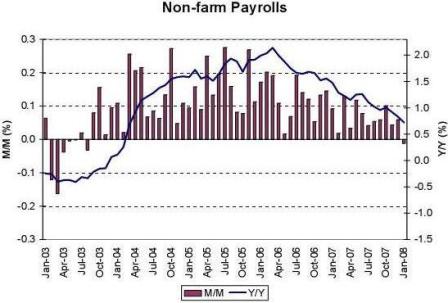
Markets reacted strongly to Friday’s -17,000 non-farm payroll number. Several sources called it the first negative payroll number in 4 years.
How quickly they forget the first negative number was the initial August number of
-4,000 that contributed heavily to the FOMC’s first rate cut. That number was revised upward the next month by close to 100,000 jobs and, if initially reported ‘correctly,’ might have changed the size of that rate cut. And, like the recent January number, the initial August number had a negative number for government workers that was subsequently revised upward and accounted for the majority of the revision.
Likewise, December’s initial report was weak, and the Fed reacted and markets traded accordingly, only to have it revised up to reasonably respectable 80,000 new jobs.
Clearly the initial numbers are far from reliable, and the initial revision is a far better indicator of the labor market conditions, with an eye out for second, third, and benchmark revisions that have also been meaningful.
So if the January number is completely disregarded and only the numbers revised at least once are considered, non-farm payrolls have been moderating but are far from levels that would indicate recession. In fact, non-farm payrolls have been reasonably steady for the second half of 07 where GDP averaged over 3% annualized, with upward revisions very possible as well, but that’s another story.
The ADP report of its near 400,000 payrolls has been a better indicator of the revised payroll numbers than of the initial payroll report. It’s also been showing the same gradual decline over the last few years as the (revised) payroll numbers due to the economy ‘using up slack’ and nearing full employment. But is has not dipped into negative territory or signaled a recession yet, further supporting the possibility of the Jan payroll number being revised up next month.
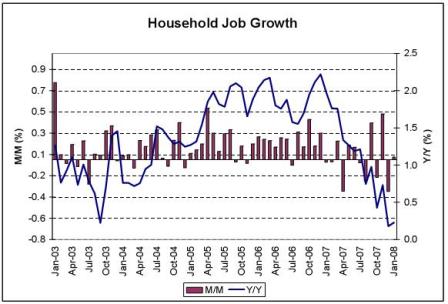
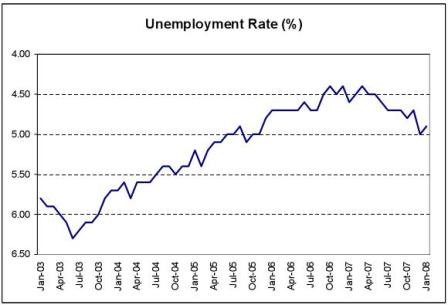
The unemployment numbers and household job growth numbers come from the household surveys, and the December jump in unemployment to 5% from 4.7% perhaps contributed even more heavily to the Fed’s latest decision to cut the fed funds rate a total of 1.25%. These are monthly survey numbers, so they are not subject to revision. The recent large fluctuations to both the upside and downside for the last 8 months are, however, on average, consistent with the above payroll reports of numbers revised at least once.

The labor force participation rate may also be an indicator of a reasonably firm labor market. At any point in time there are substantial numbers of people not actively seeking work and therefore technically not part of the labor force, but when firms make it know that they need more help some of these people are drawn back into the labor market and actively seek work. After what looks like a modest drop in the first half of 07 it seems to have recovered.
Additionally, the Fed anticipates this series to decline over time due to US demographics. That assumption would mean that over time lower payroll growth would be needed to sustain full employment, which is also consistent with what we saw for 07. In fact, Fed members (unofficially) consider a 4.75% unemployment rate to be ‘full employment.’ And anything below that risks elevating inflation expectations.
In fact, through August, the Fed’s policy was to allow unemployment to drift up to 5% to keep sufficient slack in the labor markets to keep the various inflation measures within its comfort zones.
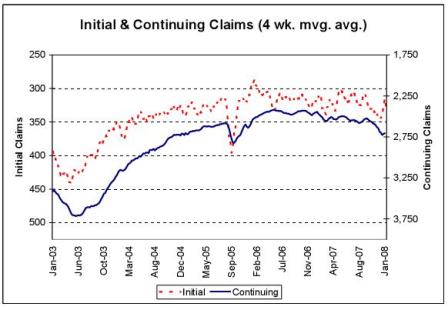
Initial unemployment claims are also not yet indicating recession, but instead staying in a range expected with a mature economy that has reached full employment and has leveled off at what the Fed considers full employment levels.
Continuing claims have moved up some, but not to anything near recession levels, and are now hovering around a level approximately consistent with the Fed’s perceived full employment level of about a 4.75% rate of unemployment.

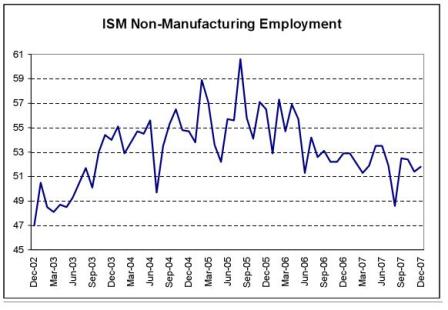
While moderating from previous levels of growth, taken together, the ISM numbers are hovering around 50. This too is consistent with an unemployment level just above the Fed’s 4.75% full employment estimate.
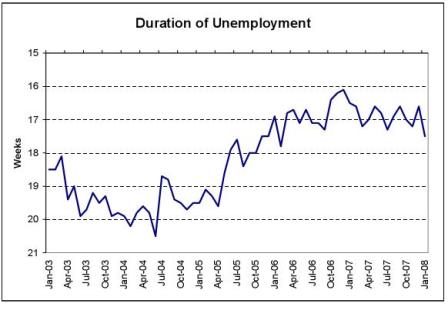
Duration of unemployment also continues to trade within a range consistent with current levels of unemployment.
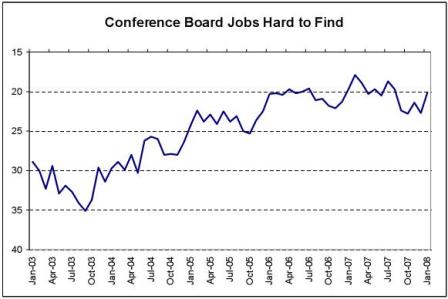
This survey as well as the ‘jobs plentiful’ survey both continue to move within a narrow range over the last 18 months.
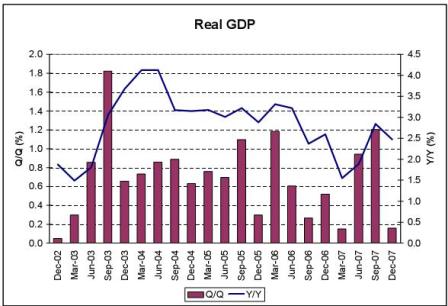
Real GDP also looks very firm. Since weak q4’s have been followed by stronger q1’s.
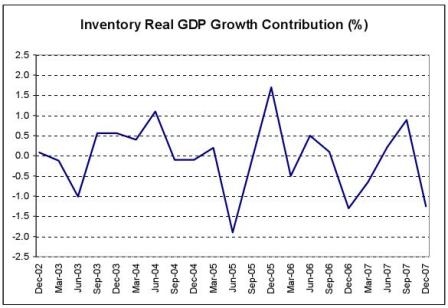
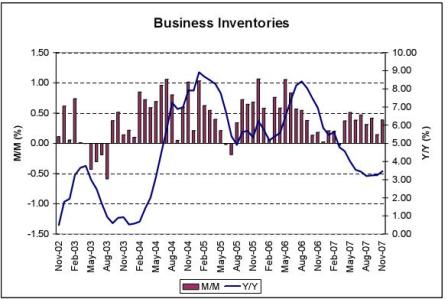
This year inventories were depleted by 1.4% in q4 and replenishing inventories from current very low levels should lend support to q1 growth. Low inventories are not indicative of a recession about to happen.
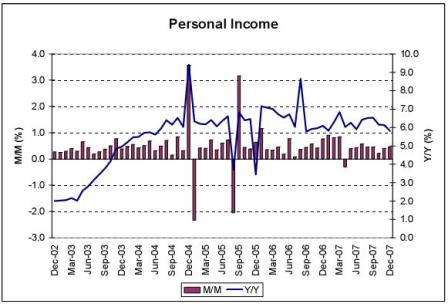
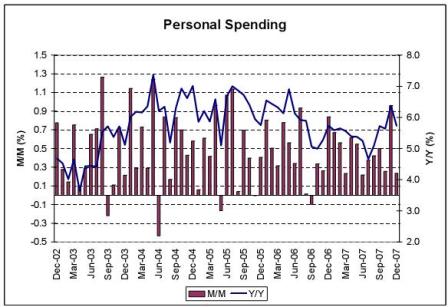
Personal income and spending are also consistent with current levels of employment and don’t yet show any sign of recession.

Durable goods are also not showing signs of recession yet.
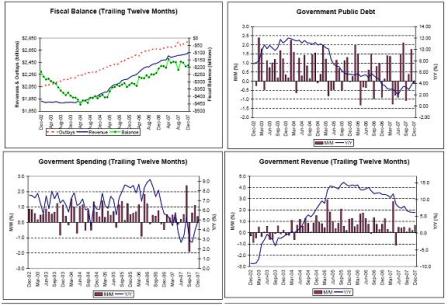
Both the non defense durable goods and the government spending charts seem to indicate government spending, including defense, may be accelerating back to previous levels. It is not impossible that some 07 govt. spending got moved forward and is beginning to kick in. Deficit spending is projected to increase by $25 billion in q1 due to increased govt. spending.
Additionally the proposed fiscal package scheduled for implementation in May could add a further 1% to q3 GDP.
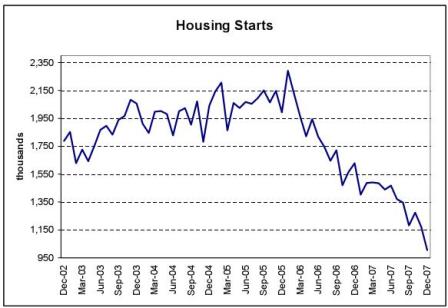
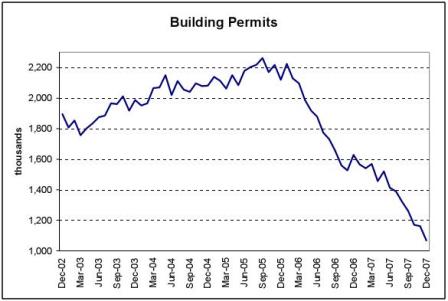
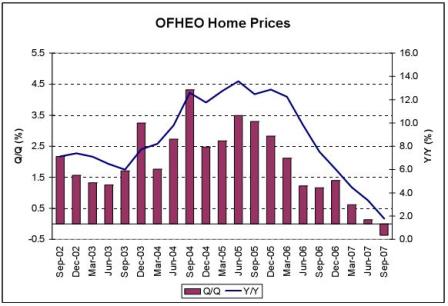
Housing remains weak, and continues to fall and subtract from GDP. And the risk that a wealth effect from falling home values could cut into consumer spending is pervasive.
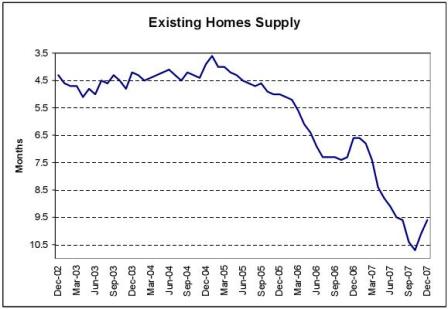
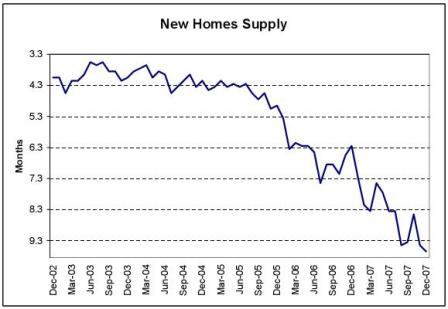
Absolute inventories of new and existing homes have been going down for several months, even as the supply measure in months of sales kept falling due to falling monthly sales rates.
An increase in the rate of sales from current low levels will quickly reduce the months of inventory.
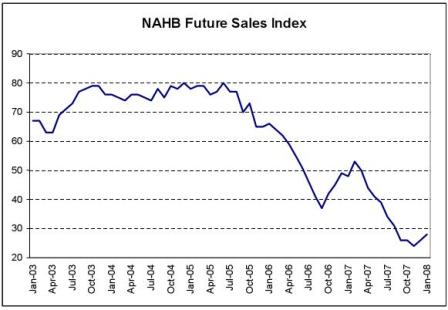
Sales may have bottomed in October/November.
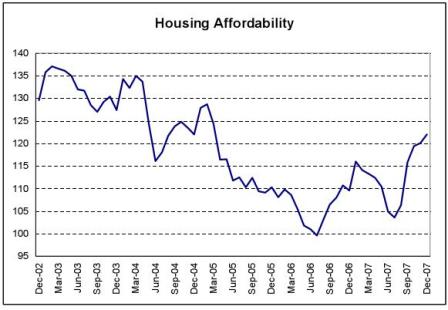
Lower prices, lower interest rates, and higher incomes all coming together.
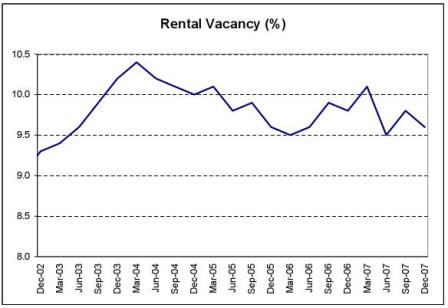
This continues its modest, multi year decline. The Fed measures housing costs by calculating owner’s equivalent rent.

Refinance applications have spiked up indicating this market is functioning and credit worthy borrowers are able to obtain financing on favorable terms.
Purchase applications are also not showing signs of recession, assuming last week’s drop is not sustained.
Looks like the commercial paper market may be on the mend. Watch for bank loans losing steam as cp regains market share.


The big story for the US economy has been the rapidly growing exports. The additional GDP attributable to rising exports has so far more than offset the reduced contribution of housing.
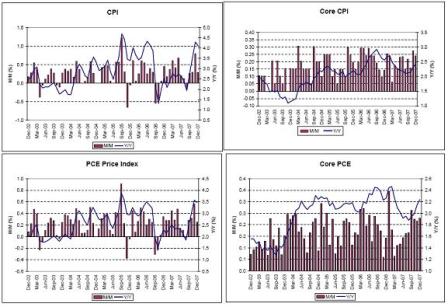
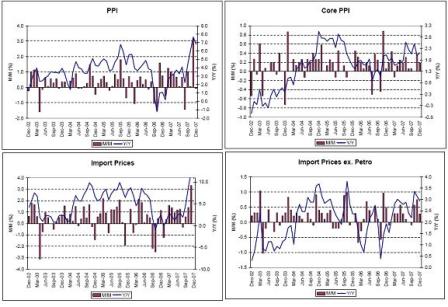
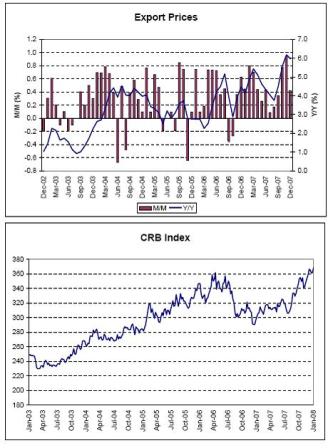
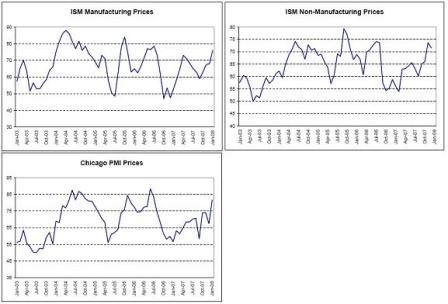

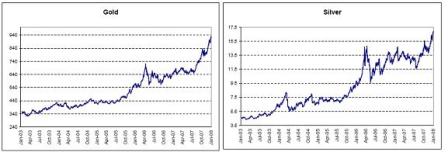
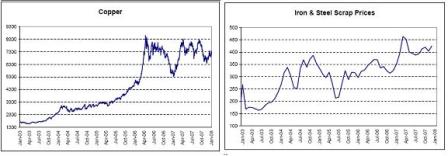
Prices have been rising at rates not seen since the great inflation of the 70’s began to wind down in the early 80’s, and the above numbers look a lot like those of the early 70’s. Additionally, it all started then and now with oil and other commodities trending sharply higher, and headline inflation indicators turning north for two or so years before core indicators followed.
The drop in prices the above charts show for the second half of 06 can be attributed to Goldman Sachs’ net reduction of the gasoline and crude oil weighting in its commodity index in Aug 06. This triggered substantial liquidations of long positions held by pension funds and other investors who were replicating the Goldman index for their investors, as well as the Goldman commodity fund itself selling gasoline and crude oil futures to reallocate to the new index. This had about run its course by year end, when at year end Goldman, and this time AIG as well, effectively further reduced the crude oil weighting in their indexes. This triggered yet another liquidation of positions. After prices bottomed and began rising again it was announced that control of the index had passed to S and P to avoid related party issues and conflicts of interest, and crude, gasoline, and other commodities resumed their former upward trends. Most have more than recovered and gone on to new highs.
Crude oil prices continue under the direct control of the Saudis, and probably the Russians as well. Saudis have been acting as ‘swing producer’ for several years, and Russia has now consolidated pricing so it can do the same. As any monopolist at the margin must do, they set price and then supply the quantity demanded at that price.
And as the Saudis have been posting ever higher prices (since the debacle of the second half of 06 previously described) the amount demanded at the higher prices has continued to increase. Last week OPEC announced that Saudi production was up to 9.2 million bpd, for example. Monthly production numbers are due out next week.
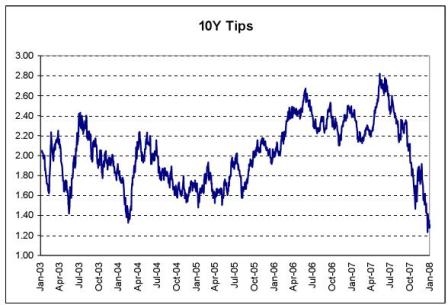
Meanwhile, the Fed has been aggressively cutting rates as what can most kindly be described as insurance against a recession. This has had an extreme effect on market expectations, as the 10 year tips are now discounting record low average ‘real rates’ by the Fed over the next 10 years, even as inflation continues to increase.
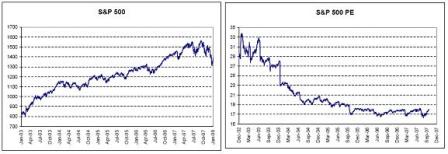
Equities remain at levels that look like very good value for long term investors.
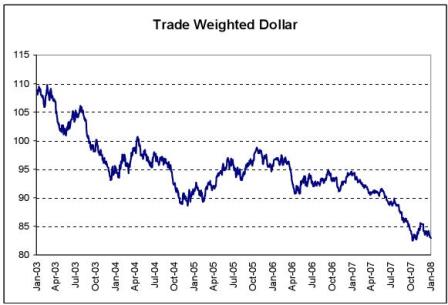
The US trade balance is a function of the desire of non residents to accumulate $US financial assets.
That desire had been increasing for a long time, as evidenced by the growing US trade deficit. And foreign Central Banks were the largest entities desiring to accumulate $US financial assets, thereby supporting their domestic export industries. Additionally, there is evidence US pension funds have been diversifying out of $US financial assets as well into both passive commodity strategies and (unhedged) foreign equities.
Three things have altered the rest of world (and our own pension fund) desire to accumulate $US financial assets, which are also evidence of a ‘weak dollar’ US policy:
This has triggered a general desire of non residents to decrease certain holding of $US financial assets. At the macro level, the way this happens is non residents first try to sell the $US in the market place, driving the price of the $US down. This continues until it reaches a level where the buyers of the $US are buying the currency because prices in the US are now low enough for them to buy US exports of goods and services, as well as US non financial assets including real estate.
Therefore I expect exports to continue to accelerate until non resident holdings of $US financial assets reach desired levels.
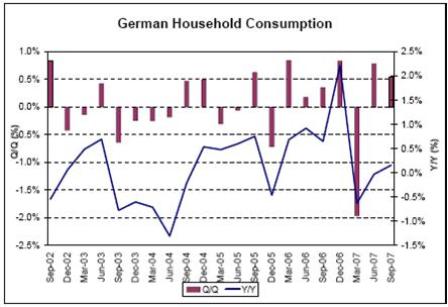
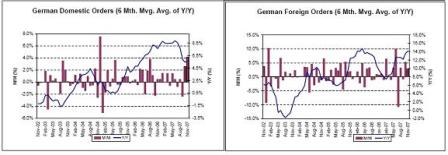
This is what export economies look like. Employment is high, but domestic prices are high enough so that domestic compensation (including government consumption) isn’t enough to buy the output, with the rest of the output being exported.
We are seeing that in the US. Domestic real consumption is moderating due to high energy and prices of other imports, while exports take up the slack in demand and support what the Fed considers near full employment levels.
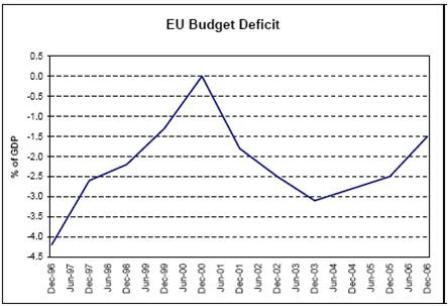
The Eurozone is seeing much the same thing. Declining budget deficits contribute to relatively low domestic demand and domestic consumption, ..
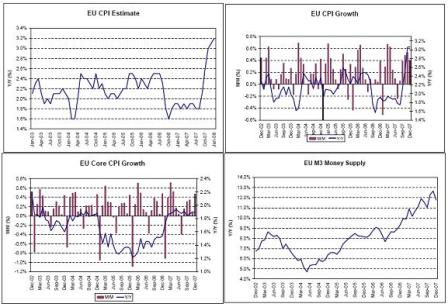
..while high inflation indicators persist even as growth slows.
♥
stagflation there too
| Actual | Forecast | Previous | |
| 6:00am EUR CPI y/y (p) | 3.2% | 3.1% | 3.1% |
| 6:00am EUR Consumer Confidence | -12 | -10 | -9 |
| 6:00am EUR Unemployment Rate | 7.2% | 7.1% | 7.2% |
♥
Same twin themes taking hold – weakness and inflation.
| Highlights: |
| US | Mixed data |
| EU | Softening data could change ECB’s inflation rhetoric |
| JN | CPI Higher on food, energy prices; Mixed data continues |
| UK | Housing Market Continued To Show Weakness |
| AU | Businesses Less Confident About Q1 economic outlook |
♥
Fiscal package is on its way!
♥
Looks like it will take a very large drop in home prices to slow the ‘pull’ on owner’s equivalent rent (the basis for the CPI housing component).
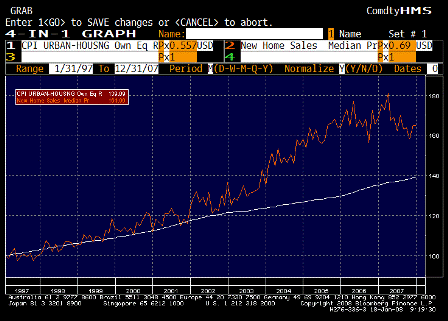
♥
(email)
On 11 Jan 2008 11:17:34 +0000, Prof. P. Arestis wrote:
>  Dear Warren,
>
>  Many thanks. Some good comments below.
>
>  The paragraph that I think is of some importance is this:
>
> > The Committee will, of course, be carefully evaluating incoming
> > information bearing on the economic outlook. Based on that evaluation,
> > and consistent with our dual mandate, we stand ready to take
> > substantive additional action as needed to support growth and to
> > provide adequate insurance against downside risks.
>
>  If I am not wrong this is the first time for Bernanke that the word
>  inflation does not appear explicitly in his relevant statement. But also
>  there is no mention of anything relevant that might capture their motto
>  that winning the battle against inflation is both necessary and sufficient
>  for their dual mandate.
>
>  Are the economic beliefs of BB changing, I wonder? I rather doubt it but
>  see what you think.
Dear Philip,
I see this is all part of the Bernanke conumdrum.
Implied is that their forecasts call for falling inflation and well anchored expectations, which can only mean continued modest wage increases.
They believe inflation expectations operate through two channels-accelerated purchases and wage demands.
Their forecasts use futures prices of non perishable commodities including food and energy. They don’t seem to realize the
‘backwardation’ term structure of futures prices (spot prices higher than forward prices) is how futures markets express shortages.
Instead, the Fed models use the futures prices as forecasts of where prices will be in the future.
So a term structure for the primary components of CPI that is screaming ‘shortage’ is being read for purposes of monetary policy as a deflation forecast.
Bernanke also fears convertible currency/fixed fx implosions which are far more severe than non convertible currency/floating fx slumps. Even in Japan, for example, there was never a credit supply side constraint – credit worthy borrowers were always able to borrow (and at very low rates) in spite of a near total systemic bank failure. And the payments system continued to function. Contrast that with the collapse in Argentina, Russia, Mexico, and the US in the 30’s which were under fixed fx and gold standard regimes.
It’s like someone with a diesel engine worrying about the fuel blowing up. It can’t. Gasoline explodes, diesel doesn’t. But someone who’s studied automobile explosions when fuel tanks ruptured in collisions, and doesn’t understand the fundamental difference, might be unduly worried about an explosion with his diesel car.
More losses today, but none that directly diminish aggregate demand or alter the supply side availability of credit.
And while the world does seem to be slowing down some, as expected, the call on Saudi oil continues at about 9 million bpd,
so the twin themes of moderating demand and rising food/fuel/import prices remains.
I also expect core CPI to continue to slowly rise for an extended period of time even if food/fuel prices stay at current levels as
these are passed through via the cost structure with a lag.
All the best,
Warren
>
> Best wishes,
>
> Philip